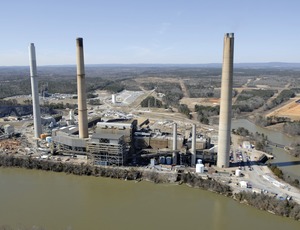
For decades, Southern Co. has been one of the nation's largest electric utilities and one of the leading consumers of coal. Southern believes coal-fired capacity should remain part of its generation mix. Its Mississippi Power subsidiary—one of four utilities Southern owns—is building what may be one of the last coal-based units in the U.S.: a 582-MW integrated gasification combined-cycle (IGCC) unit, sited in Kemper County, that is scheduled to come on line by the end of this year.
 |
Southern has responded. The Kemper County IGCC project is designed to capture 65% of the coal unit's CO and pipe it for use in enhanced oil recovery. Just as important, the company has been building new, natural-gas-fired combined-cycle projects, including three 840-MW units at its Georgia Power subsidiary's Plant McDonough-Atkinson, Cobb County, that replaced two coal units in 2011 and 2012, respectively.
More recently, Georgia Power has announced plans to retire more than 2,000 MW of older, coal-fired capacity, rather than retrofit those units with additional emissions controls to bring them into compliance with the EPA's Mercury and Air Toxics Standards (MATS), which go into effect in April 2015.
 |
| CUROW |
Yates units 6 and 7 are each 350-MW, pulverized-coal units that "would be affected by MATS should they retain coal as their primary fuel," says Mark Schwartz, Georgia Power's project manager. The units, in Coweta County, are also subject to the so-called Georgia Multipollutant Rule, "which requires that the units either install selective catalytic reduction equipment and a scrubber or switch from coal to natural gas."
Schwartz says a cost-benefit analysis compared equipping Yates units 6 and 7 with the necessary controls to comply with MATS and the multipollutant rule with other alternatives. The analysis found that conversion to natural gas would be the most cost- effective option.
"The conversion work includes installing natural-gas burners in the boilers and all the necessary electrical upgrades, piping, valves, control-system work and other systems," says Schwartz, noting that Yates already has a natural-gas supply line to the site.
Subsystems Must Be Replaced
"We are currently in the detailed engineering and major-equipment procurement phase of the project," Schwartz says. "The boiler itself remains essentially intact. However, many of the detailed systems or subsystems, such as burners, electrical, piping or control systems, will require changes or replacement."
Schwartz says the Yates coal-to-gas conversion project is being managed by Southern's in-house construction management team. "Installation work will be competitively bid at the appropriate time," he says.
With so much seemingly similar work planned at Yates and Gaston, can the work be done in an almost repetitive fashion? "This work cannot be done assembly-line style," says Schwartz. "Although some economies of scale can be realized by working on multiple units, the boilers themselves are large and complex, and the work must be tailored to each unit."

Post a comment to this article
Report Abusive Comment